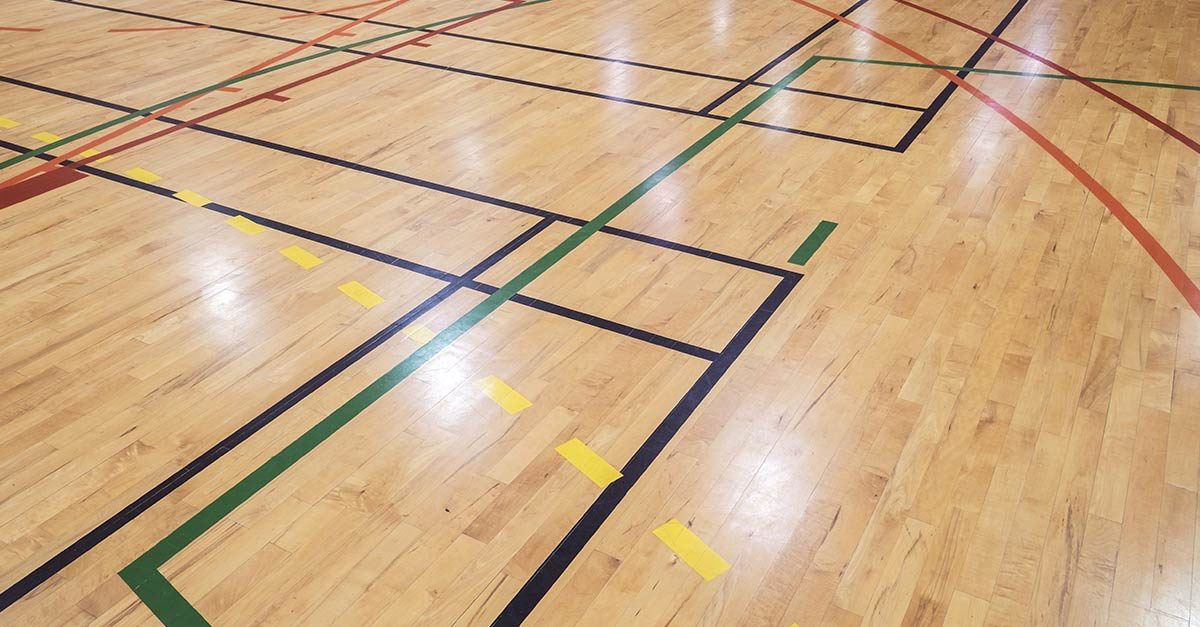Facility managers tasked with protecting hardwood gym floors, such as those in schools or recreation centers, will find creating a gym floor management program a good first step.
As many school and park and recreation budgets are tight or frozen, protecting and maintaining their hardwood gym floor is a high priority. Although there are different types of gym floors that are less expensive than a traditional maple hardwood gym floor—such as vinyl and synthetic floors—most administrators prefer to install hardwood. These floors have more shock absorption and are invariably preferred by athletes and coaches.
The initial cost for a wood gym floor is around US$65,000, depending on the size of the floor and other variables, significantly more expensive than most floor alternatives. However, wood gym floors should last about 50 years, compared to 15 to 20 years for a vinyl or synthetic floor. That 50-year life expectancy is dependent on how well the gym floor is protected, cleaned, and maintained—that’s where the gym floor management program comes in.
Choose Events Carefully
The core of the floor management program starts with prioritizing and scheduling the use of the gym. Throughout the year, many different types of activities may be held in the gym such as:
- Varsity games
- Sports practice sessions
- Club, organization, and community meetings
- Musical events
- Voting.
An effective gym floor management program allows facility managers to choose which types of events to allow on the gym floor. For instance, they may give the thumbs-up to most sporting events, but a big thumbs-down to meetings, musical events (especially if they require that chairs be placed on the gym floor), and even voting.
The problem with voters is you never know what kind of shoes they are wearing. Their footwear can range from stiletto high-heel pumps to rubber-soled shoes, many of which can damage hardwood gym floors.
Provide Protective Coverings
Installing a proper matting system will stop help keep debris off the floor. Matting systems involving three types of mats—each five feet or longer—can be installed at all gym entries. While manufacturers use different terms to describe these types of mats, they all are designed to do essentially the same thing. The three kinds of mats include:
- The scraper, placed directly outside the gym, intended to scrape large debris off shoe bottoms
- A wiper/scraper, installed directly inside the gym to continue the scraping process
- A wiper, on the gym floor, designed to further remove moisture and debris.
Together, the three mats can remove as much as 80 percent of the moisture and soil on shoe bottoms.
It’s also a good idea to install matting around the gym floor. This helps gather grit, dust, and debris that might develop from regular use of the gym floor.
Set Rules
The next phase of an effective gym floor management program involves preparing use and spectator guidelines. Consider adopting the following guidelines for your facility:
- No food or beverages are allowed on the gym floor (except for water for team players and staff)
- Spectators are not permitted to walk across the gym floor at any time
- Only team players, coaches, and their staff are allowed on the gym floor, and only if they are wearing sneakers.
Deliver copies of the guidelines to all organizations using the gym floor so that they are aware of the rules. Also, post signs in the gym and make announcements on the public-address system during games alerting spectators they are not to walk on the gym floor.
Don’t Skimp on Daily Cleanings
The more effectively a gym floor is cleaned daily, the more facility managers can delay interim cleanings and restorative care, which are both costly and time-consuming.
Dust or damp mop floors daily to remove grit and dust. Choose a cleaner that removes tracked-in soils that can eventually abrade and darken the floor. You may want to select cleaners, sealants, and finishes from the same manufacturer, as they are often designed to work together to make cleaning and maintenance quicker and easier.
Schedule Interim Cleanings
Purchase an automatic scrubber for interim cleanings. A 24-inch machine will typically do the job. Use a nonabrasive pad and a cleaning solution with a neutral pH level.
Some manufacturers now offer cleaners that add slip resistance and help increase floor traction. Athletes will be running and jumping on the floor, making safety a critical factor.
Interim cleaning frequencies can vary. At some facilities, interim cleaning is performed after every major sports event. This is particularly the case when facility managers want to make sure their gym floor is always “media ready.” Any floor used daily should be auto scrubbed at least twice per week to prevent sweat, moisture, and grit from getting pounded into the floor.
Prepare Ahead for Restorative Maintenance
Restorative maintenance of gym floors can be labor intensive; takes considerable skill; and often requires specialized equipment, tools, and products. Providing training and gathering the proper tools ahead of time will make the job much easier.
Follow these steps:
- Remove any surface soils from the floor
- Remove the current finish using an automatic scrubber
- Refinish the floor with a product specially designed for a gym floor. Apply a minimum of three or four thin coats.
Select a floor finish specifically designed to resist wear and soiling, and to promote safety through effective slip resistance. Remember, the finish dries from the top down so allow enough time for it to thoroughly dry between coats. Fortunately, some gym floor finishes can now dry in under five minutes.
Gym floors that undergo years of heavy use may need resurfacing. This process can be quite involved and includes:
- Repairing or replacing damaged sections of the floor
- Sanding down the floor a minimum of three times with a ride-on sanding machine, traveling in different directions each time
- Thoroughly cleaning and vacuuming the floor
- Staining the floor, then applying a sealant and a finish.
Save Time and Money
A gym floor management program is crucial for preserving your facility’s investment. Protecting the floor and following proper cleaning strategies are key components of the management program. Fortunately, with new cleaning solutions and finishes designed for gym floors, facility managers can reduce the time and costs to maintain them. This makes it easier to keep gym floors always looking and performing their best.



